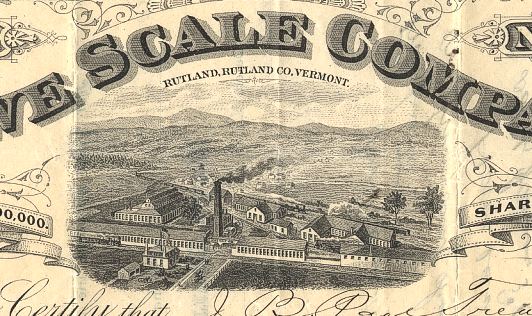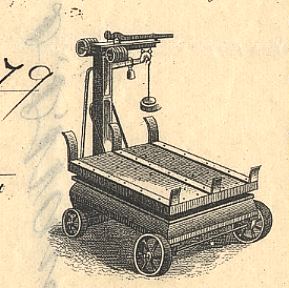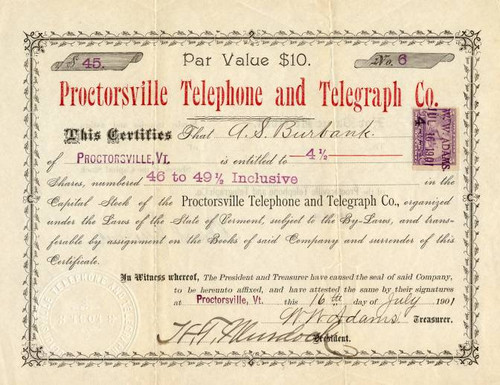Beautiful certificate from the Howe Scale Company issued in 1879. This historic document was printed by Graphic Banknote Company and has an ornate border around it with a vignette of a small town and one of the company's scales. This item has the signatures of the Company's President, G. Merrill and Secretary, W. H. Bryant and is over 130 years old. The certificate was issued to John Boardman Page and signed by him on the verso. 
Certificate Vignette 
Certificate Vignette The invention of the Howe scale dates from the year 1855, when F. M. STRONG and Thomas ROSS, two young men of energy and mechanical genius, began studying the problem of how to make a perfect weighing device. Their success was ample and in 1856 their first patent was secured. In the fall of the same year they put up their first scale in Vernon, N. Y. About the same time they finished and exhibited specimens of their hay scales and other smaller styles at the fair of the American Institute, in New York, where they attracted favorable attention. In the spring of 1857 John Howe, jr., then of Brandon, Rutland county, became impressed with the value of the invention, purchased the patent of the inventors and began their manufacture at Brandon. A stock company was subsequently organized and the business continued until 1877; but the works at Brandon were not conveniently situated relative to railroad shipments, and it was determined in 1877 to remove the entire plant to Rutland. In making this change Hon. John B. PAGE was largely instrumental and has ever since held the office of treasurer or president of the company. Eleven acres of land, a tract triangular in shape, situated at the junction of the Central Vermont and the Bennington and Rutland railroads, was purchased and during the years 1877-78 commodious and convenient buildings were erected for the works; to these various additions have since been made. A careful study was made to adapt the buildings to their several purposes in the best possible manner. A thorough watch service was instituted, and for protection from fire hydrants were located on the gounds, supplied by a powerful pump and furnished with ample hose. The buildings are all of one story, wood, lined with brick and supplied with the best apparatus for carrying on all of the various branches of the work. We cannot go into a detailed description of the advantages which the Howe scale possesses over others; but, in brief, their chief advantage (and it is a most important one) rests in the placing of chilled iron balls between the platform and the bearings which rest upon the delicate knife edges which contribute to the accuracy of the scale. The principal effect of these balls is to relieve the knife edges, upon the preservation of which depends the wear of the scale and its continued accuracy, from all possibility of injury from the inevitable oscillation of the platform when placing goods upon it. No other scale uses this feature, which is covered by patents. The Howe Scale Company is one of the institutions of Rutland and has contributed much to its growth and prosperity. From two hundred and fifty to four hundred hands are employed on the average. The annual value of the product of the company is now from $1,000,000 to $1,250,000. Howe Scale History In the years before the Civil War, Frank M. Strong worked for the Sampson Scale Company. In 1856 he took out a patent on a system that eliminated as much friction as possible when weight is transmitted from the platform where something rests on the scale when something is registered. Platform scales had been in use for a couple of decades before, but they were clumsy and inefficient. Strong took Thomas Ross, a friend, as a partner. They were looking for someone with a plant big enough to turn out the devices they were designing. They met John Howe, Jr., who had a foundry in Brandon. Howe took Strong and Ross into partnership. Strong's patent of what was known as the "cup and ball" method produced scales that won top prizes and much praise nationwide, and remained a feature of scale making for years to come. Howe bought out Strong and Ross in 1864, and by 1869 the Brandon shops and equipment were bought by Nathan T. Sprague, Jr. of Brandon, thus founding the Brandon Manufacturing Company. The name "Howe" was so well known nationally that Sprague continued to use the name on the product. One of Sprague's partners was John Boardman Page of Rutland, who was also a director of the Rutland & Burlington Railroad, and had always been interested in promoting Rutland business. In 1872, the Brandon plant was severely damaged by fire, and although it recovered, Page increased the pressure to move to Rutland. Next to Strong's Avenue in Rutland, the railroad line to New York went south and the line to Boston branched off to the east. It was in that angle that Page and others decided the scale company should be located. In 1877, the Howe Scale Company came to that railroad angle, and the Howe name has remained ever since. The plant became a model of fire-proof construction, with up to 800 workers making it the largest employer in Rutland. Howe operated three shifts around the clock, producing up to four million pounds of castings annually and shipping tens of millions of dollars worth of finished goods, making it the second largest industrial scale maker in the world. Howe manufactured scales used for weighing everything, from a single human hair to jumbo Boeing jets. Howe scales were sold throughout the world, and many Howe scales are still in use today. Unfortunately, as market conditions changed, the plant closed in 1982. Both the city of Rutland and Aero-Jet General, Howe's parent company, made many attempts to revive the abandoned plant. Several different uses were considered for the site. One, proposed by a New York developer, was to demolish the entire plant and construct a new mall. Another was as a location for the Viacom trash incinerator. Still, the site sat vacant for over five years, with its only tenants being a security guard and whatever wildlife chose to make it their home. A final option considered by Aero-Jet was to fence the entire property off and leave it unused. This was predicated on the discovery of hazardous waste on the property. John Boardman Page, .n of William and Cynthia Amanda (Hickok) Page, was born February 25, 1826, at Rutland, Vermont. He was educated in the public schools in Rutland and at Burr and Burton Seminary, Manchester, Vermont. At the age of sixteen years he entered the employ of the Bank of Rutland, and when his father resigned the cashiership on account of advancing years, John B. Page was appointed cashier. He was elected president of the bank in 1861, and continued as such after its reorganization as the National Bank of Rutland. Mr. Page's remarkable business capacity was early- recognized, and he became prominently connected with various important railroad and business enterprises. He was trustee of the Rutland & Burlington Railroad Company till he resigned this position in 1867, to become president of the Rutland Railroad Company at the date of its organization in July of that year. He remained president of the Rutland Railroad Company until August i, 1883. From 1873 to 1881 he was president of the Continental Railway and Trust Company, organized to build the New York, West Shore & Chicago Railroad, afterwards known as the West Shore Railroad. He was for many years a director in the Champlain Transportation- Company, which controlled the steam navigation of Lake Champlain, and was identified with the project to connect the waters of the St. Lawrence and Lake Champlain by the Caughnawauga ship canal. He was a director of the Howe Scale Company from 1869 to 1885, and, having acquired a controlling interest in that corporation,, he removed the shops from Brandon to Rutland in 1878. He was treasurer of the Howe Scale Company from 1876 to 1885, and a director of the Dorset Marble Company, 1871 to 1885. Mr. Page was called to many civil offices of responsibility and trust. Few men, if any, in the history of Vermont, have held more or more important offices in civil life. He was the first treasurer of the village of Rutland, 1848 to 1850. and a trustee of the village in the years i84Q, 1860, 1869, 1876 and 1877. He was treasurer of the town of Rutland from 1840 to 1856. He was elected to the legislature in 1852, when he was twenty-six years of age, and subsequently represented Rutland in the house of representatives in the years 1853, 1854 and 1880. During his last term in that body he prepared and intro duced a bill reforming the tax laws of Vermont (then much needing amendment), the main principles of which were subsequently incorporated in the state statutes. He was nominated for state treasurer, on the Republican ticket, in 1860, and held the office by successive re-elections for seven years, covering the Civil war and the most important period in the financial history of the state. He disbursed during this period, on state account, four million six hundred and thirty-five thousand one hundred and fifty dollars, principally for military expenses. He favored and promoted much of the important military legislation of that time, including the laws for adding the state pay of seven dollars a month to the government pay of the soldiers, and the law permitting soldiers to allot their pay so that it could be drawn by the selectmen of their respective towns for the support of their family during their absence in the field. He was appointed allotment commissioner for Vermont by President Lincoln. His arduous and responsible services as treasurer were recognized by the people in a call to the chief magistracy of the state. He was elected governor of Vermont in 1867, re-elected in 1868, by a larger majority than had been given to any other candidate for that office up to that time. He was then forty-one years of age, and the youngest man that ever held that office, being a few days younger than Governor Van Ness was when the latter was inaugurated. His administration was a successful and honorable one. After retiring from the governorship he declined further political office, with the exception of a term in the legislature. During the maturer years of his life Governor Page had an important place in the religious life of the community. Joining the Congregational church in 1858, he served on several important committees of the church and society. He was chairman of the building committee for the new Congregational church on Court street, Rutland. He was a deacon of the church for the last fourteen years of his life, and superintendent of the Sunday-school for twelve.years. He served as a member of the prudential committee, and as the moderator of the society. He was strongly interested in Christian missions in foreign lands. He was a corporate member of the American board of commissioners for foreign missions, and through his instrumentality the annual meeting of the board in 1874 was held in Rutland, the only meeting of the board ever held in Vermont. The arrangements for this meeting and for the accommodation of the large numbers of persons from many states who attended it, were conducted by Governor Page with extraordinary energy and success. Moved by the appeal of Joseph Neesima, he led the movement at that meeting which culminated in the establishment of the Christian college in Japan, of which Neesima became the president. The power of his personality was again strikingly shown at a meeting of the board of Providence, Rhode Island, in 1877, when he led a movement to raise the debt of the board. The officers of the board deemed the effort inexpedient at that time, but he persisted and in a couple of hours succeeded in raising forty-eight thousand dollars, which covered the entire debt. One-fourth o£ this amount was pledged by Vermonters, the largest single pledge being Governor Page's, for five thousand dollars. The scene during the progress of the effort and upon the announcement that the debt of the board had been wiped out, was one of the most impressive in the history of the American board, and Governor Page held thereafter a high place in the regard of all friends of Congregational missions.' Mr. Page married, June 14, 1848, in Boston, Mary Ann Reynolds. She died May 15, 1872, at Nice, France. Of this marriage were born four children: Susan Reynolds, who died in infancy ; William Reynolds, Edward Dimmock and Helen Louisa Page, all now living. He was married a second time, June 9, 1875, to Harriet Ellen Smith, of Winchester, New Hampshire. Their. children are: Catherine Rebecca,-John Hickok, Henrietta Richardson and Margaret Ellen Page, all living. Governor Page died October 24, 1885, and was buried in Evergreen cemetery, Rutland, which he had largely helped to establish and adorn. As will be seen from the facts stated, Governor Page was a man of marked personality, of remarkable energy and executive ability, and of high traits of personal character. He had the power of making and holding many friends, and his name has an honored place in the history of his state.

Certificate Vignette

Certificate Vignette








